Abstract
To meet energy-saving requirements, in recent years, Saudi Arabia’s construction industry has focused on researching the use of naturally available resources as raw materials. This study looks at the behavior of Viroc, specifically using pinewood and its compression properties in eco-friendly concrete. The study demonstrates the feasibility of adding pinewood to concrete and provides a theoretical basis for the promotion of dry pinewood particles and Portland cement composite materials. The Viroc specimens used in the study are 18 mm long, 12 mm wide, and 12 mm deep. The mechanical properties of the specimens were tested and compared by using a universal testing machine (UTM) and the Ansys software program 2022. The test results show that Viroc can increase the compression strength and modulus of the construction material as well as increase its brittleness and toughness (mechanical properties). The results show that it is feasible to incorporate wood and cement, resulting in a new type of Viroc composite material in an eco-friendly environment.
1. Introduction
Viroc is a composite panel consisting of a mix of wood particles (28%), cement (61%), water (10%), and other materials (1%) and is referred to as a cement bonded particle board (CBPB) (Figure 1) [1]. It combines the flexibility of wood with the strength and durability of cement, making it suitable for a large variety of applications inside and outside, such as wall partitions, ceilings, flooring, roof sarking, decorative building elements, decking, wall cladding, and fencing. It is also suitable for use with a lathe. The types of wood used are spruce, pine, or fir timbers, which are decorated. These types of wood are preferred for their ability to react with bonding materials and hydration-cementing compounds. In addition, the recycling of wood-processing residue plays an important role in the wood-processing industry. The traditional recycling of wood-processing residue uses the feedstock of biomass fuel, activated carbon, and wood-based composite. Moreover, it is estimated that by processing each ton of mineral based products, about 30 tons of waste is generated, without any type of recovery or recycling, thus causing a high environmental impact [2]. Since wood is an organic substance, the amount and type of extracts it contains must be considered. The use of eco-friendly materials in construction and other industries has gained increasing attention in recent years due to concerns over environmental sustainability. Viroc, a composite material made from a mixture of cement, wood, and other natural fibers, is one such material that has been identified as a promising option for sustainable construction. However, there is limited knowledge about the behavior of Viroc during compression, which is a critical factor that affects its mechanical properties.
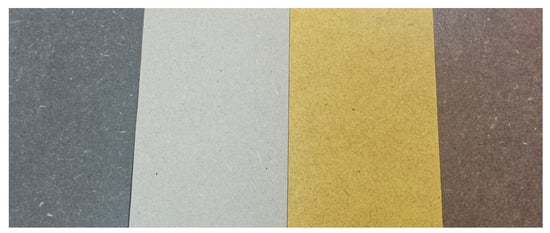
Figure 1.
Viroc’s mechanical properties.
The mechanical properties of concrete-based composites, such as Viroc, are influenced by several factors, including the type and proportion of constituents, curing time, and the manufacturing process. The same study also highlighted the need for further research to understand the behavior of these materials under different loading conditions [3]. The compressive strength of Viroc was found to increase with an increase in the cement content of the composite. However, the effect of other factors, such as the type and proportion of fibers used, has not been explored in detail [4].
These studies suggest that there is a need for further research to understand the behavior of Viroc during compression and its effect on the mechanical properties of eco-friendly materials. Therefore, the purpose of this study is to investigate the influence of Viroc behavior during compression on the mechanical properties of eco-friendly materials. By examining the behavior of Viroc and other eco-friendly materials under compression, this study aims to provide insight into their mechanical properties and potential applications in sustainable construction.
Previous research has shown that wood-processing residue is suitable for the preparation of CBPBs. The main difficulty in the manufacture of CBPB is the compatibility between cement and wood. Wood contains chemical compounds (sugars and extractives) that prevent cement from setting, and, thus, setting agents are necessary [5]. The Viroc panel has a natural look with many different shades randomly dispersed throughout the panel due to the natural colors of the raw materials used and the chemical reactions that have taken place. Tone variations are also evident on both sides of the same panel and between different production batches. Once exposed to the outside elements, the panels can change color slightly, becoming lighter. This shade variation is a natural characteristic of the panel, and no two panels will change color to the same extent. In contrast, two panels that originally had different tones may tend to be the same color when exposed to sunlight over time. Viroc panels are provided in a raw, unfinished state, with some irregularities and imperfections such as marks, scratches, and salts on the surface. A customer can request that the side of the panel that will be visible undergoes factory cleaning and polishing service, removing loose salts, dust, scratches, and dirt from the surface. The Viroc panel has two distinct faces, one sanded and one unsanded. On leaving the factory, the smooth, sanded face is the one facing upwards when the panels are loaded onto a pallet. The unsanded, rough surface is left in its natural state and, therefore, may present with dirt, scratches, and holes [6].
In particular, the behavior of Viroc under compressive loads is the focus of this paper’s contribution to the study of the mechanical characteristics of environmentally friendly materials. Due to its sustainable and eco-friendly qualities, Viroc, a composite material comprising cement and wood fibers, has seen an increase in use recently. However, little is known about its mechanical characteristics, particularly how it responds to compressive pressures. Investigating Viroc behavior under compression and how it affects its mechanical characteristics is the main contribution of the present study. To ascertain the stress–strain behavior of Viroc and the accompanying compressive modulus of elasticity, the study employed a compression test. Additionally, this paper attempts to shed light on the connection between Viroc’s compressive behavior and its mechanical attributes, including bending strength and internal bond. When building and enhancing structural applications that make use of this environmentally friendly material, it is essential to comprehend the mechanical behavior of Viroc under compressive loads. The results of this study can help in the creation of more environmentally friendly and effective building materials that can suit the needs of the construction industry. Overall, this study adds to the growing body of knowledge about environmentally friendly materials and possible uses for them in sustainable building.
Here are a few peer-reviewed articles from academic journals that talk about how the mechanical characteristics of eco-friendly materials are affected by Viroc behavior during compression. The compressive behavior of Viroc composite material was examined in this work, and it was discovered that the material displayed brittle behavior. The high cement component of the Viroc substance, according to the researchers, may be the cause of this behavior. They also mentioned that the Viroc material’s compressive strength might be enhanced by the introduction of fibers [7].
The impact of fiber content on the mechanical characteristics of Viroc was examined in this study. The researchers discovered that the Viroc material’s compressive strength and toughness were greatly increased by the addition of fibers. They hypothesized that the capacity of fibers to absorb energy and stop crack propagation may be the cause of this improvement [8].
The effect of composite materials on the compression-related mechanical behavior of Viroc panels was examined. The researchers discovered that the compressive strength of the Viroc material increased with the introduction of a higher percentage of wood particles. Additionally, they discovered that the Viroc material’s toughness and ability to absorb energy were both enhanced by the inclusion of fibers [9].
The Mechanical Properties of Cement-Based Composites [10]: This study looks into how the Viroc content affects the mechanical characteristics of composites made of cement. According to the findings, increasing the Viroc content reduces compressive strength while increasing elastic modulus.
Viroc fiber-reinforced cement-based composites are evaluated in this study for their mechanical and durability qualities. As a result, the composites’ compressive strength, flexural strength, and resistance to freeze–thaw cycles are all improved, according to the data [11].
The mechanical characteristics of sustainable concrete using Viroc aggregates are examined in this work. The findings demonstrate that while the flexural strength of the concrete increases as the Viroc level decreases, the compressive strength and elastic modulus do not [12].
The impact of Viroc aggregates on the mechanical characteristics of lightweight concrete is investigated in this study. According to the findings, the Viroc aggregates enhance the concrete’s compressive strength and elastic modulus [13].
Overall, these studies show that the influence of Viroc behavior during compression on the mechanical properties of eco-friendly materials can vary depending on factors such as Viroc content, fiber reinforcement, and aggregate type.
These investigations offer crucial information about how Viroc behavior under compression affects the mechanical characteristics of environmentally friendly materials. They contend that adding fibers and a greater percentage of wood particles can greatly enhance the mechanical qualities of Viroc materials, such as compressive strength and toughness.
2. Research Background
Increasing environmental concerns have led to a significant focus on the development of eco-friendly materials in the fields of engineering and materials science. These materials are designed to minimize negative environmental impacts and improve sustainability while maintaining adequate mechanical properties.
One of the most promising eco-friendly materials is Viroc, a composite material made from a mixture of cement and wood particles. Viroc has gained attention due to its outstanding mechanical properties, including high compressive strength, low water absorption, and good fire resistance.
However, the behavior of Viroc during compression can significantly affect its mechanical properties, and this aspect requires further investigation. The compression behavior of Viroc is influenced by various factors, including the size and distribution of the wood particles, the type of cement used, and the manufacturing process.
Understanding the influence of Viroc behavior during compression on its mechanical properties is crucial for optimizing the material’s design and improving its performance. Therefore, this study aims to investigate the compression behavior of Viroc and its impact on the mechanical properties of the material. The results of this study could provide valuable insights into the design and development of eco-friendly materials with improved mechanical properties.
The purpose of this research is to investigate the influence of Viroc behavior during compression on the mechanical properties of eco-friendly materials. Viroc is a composite material made from a mixture of cement, wood, and other natural fibers, which makes it an environmentally sustainable option. However, the behavior of Viroc during compression is not well understood, and this study aims to fill this gap by examining how it affects the mechanical properties of eco-friendly materials. The research will involve the experimental testing of different types of eco-friendly materials, including Viroc, to determine their mechanical properties under compression. The findings of this study could have practical implications for the design and use of eco-friendly materials in construction and other industries.
As we work towards better protecting the environment, we will confront additional problems that will require more effective and efficient solutions, including lighter, more economical, and stronger materials. We will continue to use cars with huge iron frames if we stop exploring new materials, such as carbon fiber or other composite materials that have greater tensile strength, are lightweight, and consume less fuel. As mechanical engineers and developers of our physical surroundings, it is our responsibility to safeguard the world’s future.
Viroc is a new composite construction material that can be used instead of some existing materials. When compared to other materials, Viroc is regarded as one of the most modern materials available. It is not widely used yet, which is why our primary role as mechanical engineers in this project is to perform mechanical tests to determine its characteristics and, as a result, its potential use, determining whether it can be widely distributed [14].
This project focuses on the mechanical properties of Viroc obtained by tests using a tensile testing machine and electronic simulation. The tests consider the reasons that led us to choose Viroc over other available materials, including economic considerations. As mechanical engineers, we will calculate and evaluate the stresses in specific sections of the Viroc specimens. We will consider the different sites in which it is used and the different stresses affecting it depending on the application. This will help to determine the best fields of application for the material.
There are other approaches to reducing emissions related to the fabrication of building construction materials, such as foamed concrete (FC) and lightweight concrete. FC can be produced with soil or slag powder and is suitable for the thermal insulation of walls or for backfill [15]. Recent studies have also shown that potentially problematic wastes, such as polystyrene and cement kiln dust, can be mixed to create lightweight cementitious bricks as an eco-friendly alternative to traditional cement bricks [16].
The following are important concepts and terms related to this study:
- Viroc: Made of cement and wood shavings. Viroc is a composite material. It has been employed in many different contexts, such as building and furniture [17].
- Compression test: A mechanical test of this kind involves applying a compressive load to a material and observing how it responds. It is commonly used to determine a material’s elastic modulus and compressive strength [18].
- Universal testing machine (UTM): A UTM is a device used to evaluate the strength, elasticity, plasticity, and other mechanical characteristics of materials. It applies a load to a specimen and measures its deformation [19].
- Ansys: Ansys is a simulation tool used for engineering analysis, particularly for simulating mechanical, electrical, and hydraulic systems [20].
- Mechanical properties: The mechanical properties of a material refer to how it responds physically to a load or applied force. These properties include toughness, ductility, stiffness, and strength [21].
- Composite material: A composite material is a substance made by combining two or more distinct components to achieve desired properties. Examples of composite materials include fiberglass, carbon fiber, and Viroc [22].
2.1. Material
Viroc is a composite material consisting of a compressed and dry mixture of pinewood and cement, and it is used in structural fields. It is a heterogeneous material. Different colors of Viroc have slightly different compositions. For example, gray and white have the same composition, as do yellow, red, and black. The mechanical properties of Viroc are presented in Table 1.

Table 1.
Viroc’s mechanical properties [6].
2.2. Technical Specifications
The technical details of Viroc, an environmentally beneficial substance, are listed in the table above according to its mechanical characteristics. The attributes of Viroc being measured are listed in the table’s first column. Each feature’s unit of measurement is listed in the second column. The value of each feature is given in the third column, and the standard by which each feature was measured is listed in the last column.
The density of Viroc, which is expressed in kilograms per cubic meter (kg/m3) and has a value of 1350 ± 50, is the first characteristic stated. Using the EN 323 standard, this value has been established.
The swelling of Viroc, which is assessed as a percentage (percent) after 24 h and has a value of 1.5 percent, is the second characteristic. Using the EN 317 standard, this value has been established.
The third characteristic is Viroc’s moisture content at the time of manufacturer dispatch, which is expressed as a percentage (percent) and ranges from 9 to 12 percent. Using the EN 322 standard, this value has been established.
The fourth characteristic is Viroc’s modulus of elasticity, which has a value of 4500 newtons per square millimeter (N/mm2). Utilizing the EN 310 standard, this value was established.
The internal bond of Viroc, which has a value of 0.50 in newtons per square millimeter (N/mm2), is the fifth characteristic. Using the EN 319 standard, this value has been established.
The sixth characteristic of Viroc is its bending strength, which has a value of 9 newtons per square millimeter (N/mm2). The EN 310 standard is used to calculate this value.
The surface alkalinity of Viroc, which is evaluated using pH units and has a value range of 11–13, is the eighth characteristic.
The thermal conductivity of Viroc, which is expressed in watts per meter Celsius (W/m.C) and has a value of 0.22, is the seventh property. To calculate this number, the EN 12664 standard was used.
The increased heating value of Viroc, which has a value of 4 +/− 0.5 megajoules per kilogram (MJ/kg), is the eighth attribute. To calculate this number, the EN ISO 1716 standard was used.
2.3. Advantages
The advantages of Viroc over other composite construction materials are as follows:
- Non-toxic;
- Sound insulation;
- Weight resistance;
- Easy installation;
- Fire retardant;
- Moisture resistance;
- Thermal insulation;
- Withstands hot temperatures;
- Insect resistance.
2.4. Applications
Viroc can be used in metallic or wooden supporting structures. Its applications are divided into two main areas depending on the environment: inside or outside. The difference between the environments is the effect of sunlight, air, humidity, and other external conditions. Outside environments may require additional safety considerations compared to inside environments [14].
Facades
Modern architecture, with its emphasis on light and transparency, poses various challenges for design, construction, and operation, mainly in the case of facades. Thermal necessities additionally want to be considered.
3. Methodology
We will test the compression qualities of Viroc in three ways. First, we will take five specimens and test each one by using the UTM. Second, we will prepare a simulation by using the Ansys software program. Finally, we will analyze the different results from the UTM and Ansys programs.
The study on the influence of Viroc behavior during compression on the mechanical properties of eco-friendly materials requires a thorough investigation of the material’s behavior under different loading conditions. While physical tests can provide valuable data, simulation tests can complement these tests by providing a more comprehensive understanding of the material’s behavior.
Simulation tests involve creating computer models of the material and subjecting them to different loading conditions. By varying the parameters of the simulation, researchers can study the effects of different factors, such as temperature and pressure, on the material’s behavior. These tests can also be used to predict the material’s behavior under different loading conditions, which can be useful in designing new products or optimizing manufacturing processes.
In addition to simulation tests, physical tests can also be conducted to validate the results obtained from the simulations. For example, researchers can conduct compression tests on samples of the material and compare the results to those obtained from the simulation. This helps to ensure that the simulations accurately represent the material’s behavior under real-world conditions.
During compression testing, load and position curves are typically obtained, which provide valuable information about the material’s behavior and mechanical properties. The load curve shows how the load applied to the material changes over time, while the position curve shows how the material’s position changes in response to the load. By analyzing these curves, researchers can identify the material’s elastic and plastic properties, as well as its yield and ultimate strength.
Overall, combining simulation tests with physical tests can provide a more comprehensive understanding of the behavior of eco-friendly materials such as Viroc under different loading conditions. By using both approaches, researchers can validate the results obtained from each and gain a more accurate understanding of the material’s behavior, which can be useful in developing new products and optimizing manufacturing processes.
3.1. Raw Material
The Viroc specimens were obtained from a ceramic residue shop. The specimens are a composite of dry pinewood debris and Portland cement. Viroc was first produced in a factory in France in 1979 with production moving to Portugal in 1992 [23].
3.2. Preparation and Conditioning of Test Specimens
The specimens used (Figure 2) are 18 mm long, 12 mm wide, and 12 mm deep. In our experiment, I utilized a cutter machine to achieve the precise size, and I performed a compression test on 5 samples to determine their mechanical properties. The main property of our research is elasticity to see the behavior of Viroc material.
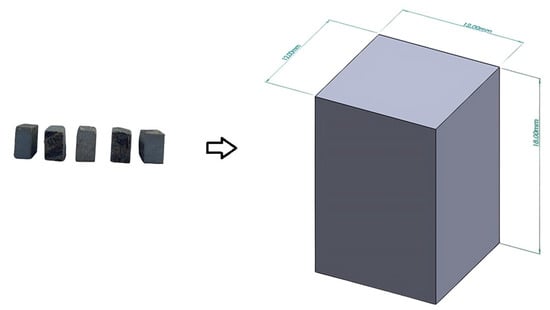
Figure 2.
Dimensions of the specimens: This figure shows the dimensions of the test specimens used in the study. The dimensions are important in determining the size and shape of the specimens that were subjected to compression testing.
3.3. Compression Test Machine
The UTM (Figure 3) is configured to measure a specimen’s electronic and deformation behavior under a compressive load. A standard compression test includes a load cell, crosshead(s), compression check tools, electronics, and a force system. The UTM is managed by a software program that controls various settings and parameters according to standards set by the American Society for Testing and Materials. To select the proper compression and check equipment, it is essential to know the composition of the material to be examined and the standards to be followed. Measuring the pressure until the requisite load or period has been reached, or until the specimen cracks or breaks, allows designers and producers to determine whether a material is suitable for its intended purpose.
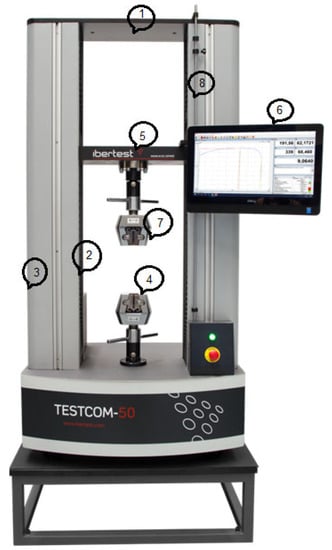
Figure 3.
UTM and universal parts: This figure shows the parts of the universal testing machine (UTM) used in the study. The figure helps to provide an understanding of the components of the UTM that were used to apply compressive forces to the test specimens.
3.4. Parts Identification
A mechanical testing tool called a universal testing machine (UTM) is employed in materials science and engineering to ascertain a material’s mechanical properties under diverse loading scenarios. A UTM’s key components are as follows:
- The fixed higher crosshead considers body stiffness.
- The mobile crosshead is actioned by screwdrivers and moves the weight towards the specimen.Crossheads: The UTM has two crossheads, one of which is fixed and the other of which is mobile. The load frame holds the fixed crosshead, which is fixed and immobile during testing. A motor powers the movable crosshead, which moves up and down to exert force on the specimen.
- The frame housing hosts and guards the screwdrivers and guiding columns.The major support and alignment framework for the other components of the UTM is called the load frame. Usually, it is constructed with sturdy, stiff materials such as steel or aluminum.
- The gripping heads. Other gripping heads and fixtures are available.Grip: During a test, the grips keep the specimen in position. Depending on the kind and shape of the specimen being evaluated, a wide variety of grips are available.
- The long tour extensometer is designed for excessive elongation materials.
- The touch–display interface uses WinTest32 software version 8 and is previously set up on an all-in-one computer.Control panel: The user can configure and launch experiments on the UTM using the control panel. A display, keyboard, and software that manages the motor and load cell are often included.Software: The UTM program manages the apparatus and keeps track of the test results. It can be used to organize and carry out tests, gather and examine data, and produce reports.
- The load cells. Universal type (tensile compression).Load cell: During a test, a load cell measures the force that is delivered to the specimen. The force is changed into an electrical signal that may be recorded and shown.
- A high-precision transducer for the degree of the crosshead position. This is mounted at the ball–screw axis.
Mechanical tests such as tension, compression, bending, shear, and torsion can all be carried out with UTMs. The information gathered from these tests can be used to estimate a material’s yield strength, ultimate strength, elastic modulus, and ductility.
3.5. The Ansys Program
The Ansys software program discovery functions as the primary simulation-pushed layout device combining instant physics simulation, high-constancy simulation, and interactive geometry modeling in a single easy-to-use experience.
4. Results and Discussion
This section of the research presents the results of the first two steps of our methodology, as shown in Section 3.1. Out of the five specimens trialed in our tests, three produced dependable results for evaluation. The results of the simulations are represented in slope graphs to show the accuracy of the trials.
4.1. Specimen Dimensions
The measurements of the Viroc samples utilized in the investigation are shown in Table 2. The samples are rectangular, measuring 12 mm in width, 18 mm in length, and 12 mm in depth. These measurements are crucial because they provide the study’s specimens with a standard size, enabling the precise and consistent testing and analysis of the material’s mechanical properties.

Table 2.
Dimensions of Viroc specimens.
4.2. Compression Stress Results
Below are the results of the compression power check (Figure 4), including the load in kilos and newtons and the position (elongation) in millimeters. The Viroc pattern, which was made with the aid of wood cement, is a brittle fabric because it cannot withstand the compression power. As the Viroc pattern was pinned and went through the uniaxial test, the assumed fracture occurred precisely on the Viroc head.
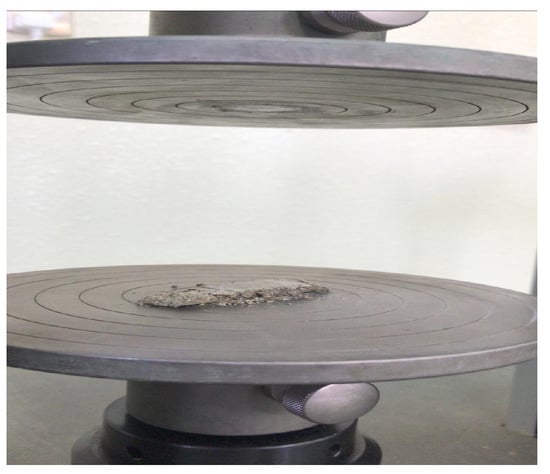
Figure 4.
Specimen After Compression Test: This figure shows an image of a test specimen after it has been subjected to compression testing. The figure helps to illustrate the effects of compression on the material and provides an idea of the changes that occur during the testing process.
4.2.1. Experimental Results for Compression
The five specimens in this research were experimentally tested to obtain very close and accurate results. (Figure 5, Figure 6, Figure 7, Figure 8 and Figure 9) show successful specimens, and the graphs below show the load and position curves a.
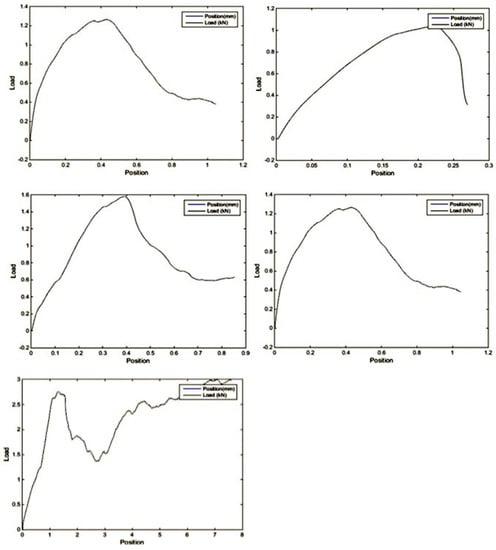
Figure 5.
Compression Load and Position Curve of samples 1–5: These figures show the load and position curves obtained during compression testing of the five test specimens. The figures help to visualize the behavior of the material during compression testing and provide information about the load and displacement values at different points in the testing process.
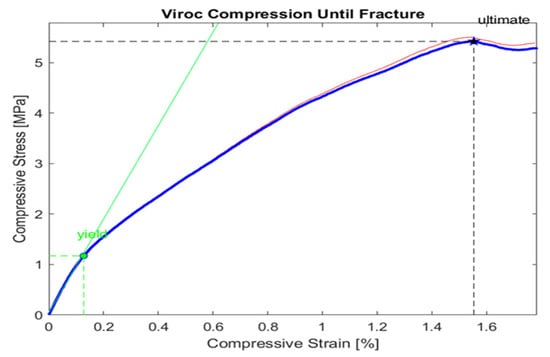
Figure 6.
Yield and ultimate point determination for the 5th test using MATLAB: This figure shows the MATLAB output used to determine the yield and ultimate points of the material during compression testing. The figure helps to provide insight into the data analysis process used in the study and the methods used to determine important mechanical properties of the material.
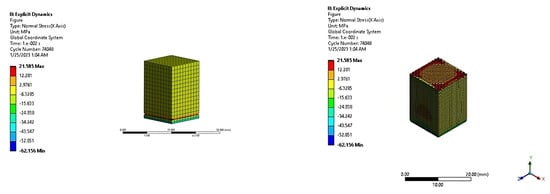
Figure 7.
Simulation Compression Test (Stress): This figure shows the stress values obtained from the simulation compression test. The figure helps to provide a comparison between the stress values obtained from the simulation and the stress values obtained from the physical compression tests.
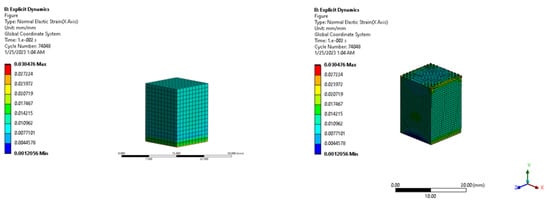
Figure 8.
Simulation Compression Test (Strain): This figure shows the strain values obtained from the simulation compression test. The figure helps to provide a comparison between the strain values obtained from the simulation and the strain values obtained from the physical compression tests.
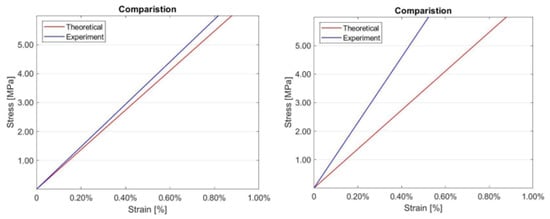
Figure 9.
Stress and Strain Diagram: This figure shows the stress and strain diagram obtained from the compression testing of the Viroc material. The figure helps to provide a graphical representation of the behavior of the material under compression and the mechanical properties of the material, including yield strength, ultimate strength, and elastic modulus.
Table 3 shows the stress–strain data for material under compression. The stress is the force per unit area applied to the material measured in megapascals (MPa). The strain is the percentage deformation or elongation of the material due to the applied stress.

Table 3.
Stress–strain data for material under compression.
Table 3 shows two important points on the stress–strain curve: the yield point (σ_y) and the ultimate point (σ_ut). The yield point is the point on the curve where the material begins to deform plastically, meaning that it will not return to its original shape once the stress is removed. The ultimate point is the point on the curve where the material fractures or breaks due to the applied stress.
In addition to the stress and strain values at the yield and ultimate points, the table also includes the compressive modulus of elasticity (E) for the material. The modulus of elasticity is a measure of the material’s stiffness and resistance to deformation under stress. It is calculated as the ratio of stress to strain in the elastic deformation region of the stress–strain curve.
Based on the data in the table, the material has a compressive modulus of elasticity of 784.54 MPa and a yield point of 10.30 MPa at a strain of 1.4%. The ultimate point occurs at a stress of 14.72 MPa and a strain of 2.82%.
4.2.2. Simulating Results for Compression
4.3. Comparing Results
The results of the two specimens (Figure 9) on which the test was performed are shown here, and we can see that the specimen on the left is closer to the simulated specimen than the other specimen. In other words, the Viroc compression modulus for the left specimen was obtained within a range of (750 ≥ Ec ≥ 850) MPa.
5. Conclusions
To verify the compressive properties of Viroc, five axial compression tests were carried out. Viroc specimens were obtained, and each specimen was 18 mm long, 12 mm wide, and 12 mm deep. Two specimens failed the test, and two of the three specimens did not match the theoretical results obtained by the Ansys Simulink software 2022 program, which is considered a reference point for these tests. As a result of the analysis of the test data, the compression modulus was equal to 800 ± 50 MPa where the yield compressive stress was 10.30 MPa. Based on these results, Viroc is suitable as a structural material with mechanical stress test properties, making it a suitable alternative to traditional materials used in construction. It also meets the requirements of Saudi Arabia’s green environment and sustainable development objectives.
Funding
This study was supported by Qassim University (grant number: 123).
Data Availability Statement
All data generated or analyzed during this study are included in this published article.
Acknowledgments
Researchers would like to thank the Deanship of Scientific Research, Qassim University, for funding the publication of this project. The funders had no role in the study design, data collection, and analysis; the decision to publish; or the preparation of the manuscript.
Conflicts of Interest
The authors declare no conflict of interest.
References
- Placonorte. Viroc Catalog. 2022. Available online: http://www.placonorte.com/Viroc.php (accessed on 16 November 2022).
- Carbonell-Verdú, A.; García-García, D.; Jordá, A.; Balart, M.S.E.R. Development of slate fiber reinforced high density polyethylene composites for injection molding. Compos. Part Eng. 2015, 59, 460–466. [Google Scholar] [CrossRef]
- Dueramae, S.; Tangchirapat, W.; Chindaprasirt, P.; Jaturapitakkul, C.; Sukontasukkul, P. Autogenous and Drying Shrinkages of Mortars and Pore Structure of Pastes Made with Activated Binder of Calcium Carbide Residue and Fly Ash. Constr. Build. Mater. 2020, 230, 116962. [Google Scholar] [CrossRef]
- Sheikhahmadi, P.; Bahramara, S. The Participation of a Renewable Energy-Based Aggregator in Real-Time Market: A Bi-Level Approach. J. Clean. Prod. 2020, 276, 123149. [Google Scholar] [CrossRef]
- Faria, G.; Chastre, C.; Lúcio, V.; Nunes, Â. Compression behaviour of short columns made from cement-bonded particle board. Constr. Build. Mater. 2013, 40, 60–69. [Google Scholar] [CrossRef]
- Investwood. Viroc Technical Data Sheet. 2020. Available online: https://www.investwood.pt/wp-content/uploads/2020/07/EN_Viroc_Technical-Data-Sheet_2020.1.pdf (accessed on 16 November 2022).
- Gholampour, A.; Ozbakkaloglu, T. Fiber-Reinforced Concrete Containing Ultra High-Strength Micro Steel Fibers Under Active Confinement. Constr. Build. Mater. 2018, 187, 299–306. [Google Scholar] [CrossRef]
- Koutas, L.N.; Bournas, D.A. Confinement of Masonry Columns with Textile-Reinforced Mortar Jackets. Constr. Build. Mater. 2020, 258, 120343. [Google Scholar] [CrossRef]
- Ferretti, F.; Ferracuti, B.; Mazzotti, C.; Savoia, M. Destructive and Minor Destructive Tests on Masonry Buildings: Experimental Results and Comparison Between Shear Failure Criteria. Constr. Build. Mater. 2019, 199, 12–29. [Google Scholar] [CrossRef]
- Ferreira, N.; Veiga, R.; de Brito, J.; Monteiro, P.; Gomes, J. Effect of Viroc Content on the Mechanical Properties of Cement-Based Composites. Constr. Build. Mater. 2016, 121, 59–67. [Google Scholar]
- Sanches, E.A.; Costalonga, A.G.C.; Nascimento, L.d.F.; Mascarenhas, Y.M.; Mascarenhas, Y.P. Recovery of α-Al2O3 from Ionizing Radiation Dosimetric Sensors. Mat. Res. 2015, 18, 113–120. [Google Scholar] [CrossRef]
- Santos, A.L.; Rodrigues, L.L. Banks and Climate-Related Information: The Case of Portugal. Sustainability 2021, 13, 12215. [Google Scholar] [CrossRef]
- Vejmelková, E.; Pavlíková, M.; Keppert, M.; Keršner, Z.; Rovnaníková, P.; Ondráček, M.; Sedlmajer, M.; Černý, R. High Performance Concrete with Czech Metakaolin: Experimental Analysis of Strength, Toughness and Durability Characteristics. Constr. Build. Mater. 2010, 24, 1404–1411. [Google Scholar] [CrossRef]
- Investwood. Cement Wood Board Technical File. 2020. Available online: https://atpol.com.pl/wp-content/uploads/catalogue/914b182787d9f27daa8df4d0109f6dfb_Viroc_karta%20techniczna.pdf (accessed on 16 November 2022).
- Yang, X.; Xu, S.; Zhao, Z.; Lv, Y. Strength, Durability, and Microstructure of Foamed Concrete Prepared Using Special Soil and Slag. Sustainability 2022, 14, 14952. [Google Scholar] [CrossRef]
- El-Sayed, A.M.; Faheim, A.A.; Salman, A.A.; Saleh, H.M. Sustainable Lightweight Concrete Made of Cement Kiln Dust and Liquefied Polystyrene Foam Improved with Other Waste Additives. Sustainability 2022, 14, 15313. [Google Scholar] [CrossRef]
- Viroc. (N.D.). Investwood. Available online: https://www.investwood.pt/viroc/ (accessed on 25 December 2022).
- Standard Test Method for Compressive Properties of Rigid Plastics. Available online: https://www.astm.org/d0695-15.html (accessed on 10 October 2022).
- Standard Test Methods for Tension Testing of Metallic Materials. 2018. Available online: https://www.astm.org/e0008_e0008m-21.html (accessed on 15 March 2023).
- ANSYS. Engineering Simulation & 3D Design Software. 2017. Available online: https://www.ansys.com/ (accessed on 15 March 2023).
- Meyers, M.A.; Chawla, K.K. Mechanical Behavior of Materials; Cambridge University Press: Cambridge, UK, 2008; Available online: https://books.google.com/books?hl=ar&lr=&id=v-_oAwAAQBAJ&oi=fnd&pg=PT18&dq=Meyers (accessed on 1 December 2022.).
- Gibson, R.F. Principles of Composite Material Mechanics; CRC Press: Boca Raton, FL, USA, 2016; Available online: https://books.google.com/books?hl=ar&lr=&id=U_cbDAAAQBAJ&oi=fnd&pg=PA1&dq=Gibson (accessed on 1 December 2022).
- Lopes, A.M.R. Viroc Portugal: Indústrias de Madeira e Cimento SA. 2012. Available online: https://recipp.ipp.pt/bitstream/10400.22/15547/1/ (accessed on 1 November 2022).
Disclaimer/Publisher’s Note: The statements, opinions and data contained in all publications are solely those of the individual author(s) and contributor(s) and not of MDPI and/or the editor(s). MDPI and/or the editor(s) disclaim responsibility for any injury to people or property resulting from any ideas, methods, instructions or products referred to in the content. |
© 2023 by the author. Licensee MDPI, Basel, Switzerland. This article is an open access article distributed under the terms and conditions of the Creative Commons Attribution (CC BY) license (https://creativecommons.org/licenses/by/4.0/).